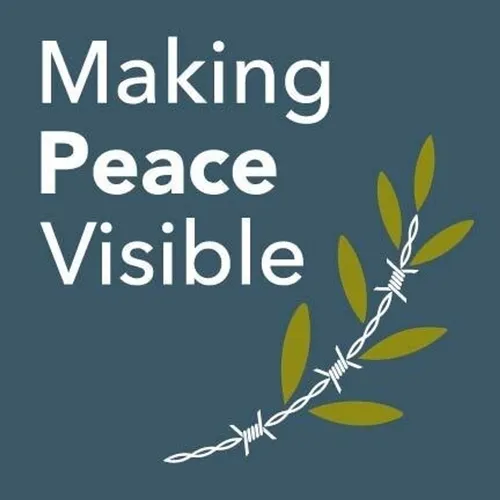
Making Peace Visible
In the news media, war gets more headlines than peace, conflict more airtime than reconciliation. And in our polarized world, reporting on conflict in a way that frames conflicts as us vs. them, good vs. evil often serves to dig us in deeper. On Making Peace Visible, we speak with journalists and peacebuilders who help us understand the human side of conflicts and peace efforts around the world. From international negotiations in Colombia to gang violence disruptors in Chicago, to women advocating for their rights in the midst of the Syrian civil war, these are the storytellers who are changing the narrative.
Making Peace Visible is hosted by Boston-based documentary filmmaker Jamil Simon.
- Update frequency
- every 13 days
- Average duration
- 32 minutes
- Episodes
- 88
- Years Active
- 2022 - 2025

Trailer
In the news media, war gets more headlines than peace, conflict more airtime than reconciliation. And in our polarized world, reporting on conflict in a way that frames conflicts as us vs. them, good…

In search of good conflict
After over two decades as a journalist, including ten years covering terrorism and disasters for TIME Magazine, Amanda Ripley thought she understood conflict. But when momentum started to build aroun…

Reporting from Iran with a bias towards peace
We want to learn more about our listeners. Take this 3-minute survey to help us improve the show!
Reza Sayah is an Iranian-American journalist, currently based in Tehran. He’s reported on major event…

Refugees and immigration: what’s missing from the narrative
As of May 2023, there were an estimated 110 million forcibly displaced people worldwide, according to the UN High Commissioner for Refugees.
Many are escaping wars, gang violence or repressive regime…

Telling murder stories differently
On Making Peace Visible, we are always questioning the mantra, if it bleeds, it leads. Boston’s Charles Stuart murder case is a classic example of what can go horribly wrong when you follow that mant…

Why we make this show: An interview with Jamil Simon
In this episode we’re featuring a recent interview with our host, documentary filmmaker and lifelong peace activist Jamil Simon on This is My Silver Lining, a podcast about ordinary people doing extr…

All the peace we cannot see
Making Peace Visible is a show about how the media covers peace and conflict. One of the major reasons we make it is because peace gets so little coverage in the news media. When we do hear news abou…

Democracy Works: Between Democracy and Autocracy
Between democracy and autocracy is an anocracy, defined by political scientists as a country that has elements of both forms of government — usually one that’s on the way up to becoming a full democr…

Unmasking American myths about war and the military
In the United States, about one sixth of the federal budget goes to defense. This year the country spent more on the military than any year since 2001 – over $816 billion. Why does spending continue …

Storytelling with equal-opportunity empathy
Trey Kay knows both sides of America's partisan divide intimately. He was born and raised in a conservative family in Charleston, West Virginia. As a young man he moved to New York City, where he la…

In Modi's India, journalists must toe the line or risk jail time
Western media has often referred to India as the world’s largest democracy. But during the last decade, the world has witnessed the decline of many democratic institutions in India. In a recent Time …

How do we design for peace?
On Making Peace Visible we usually focus on stories -- narratives about peace and conflict that are told in the news, on social media, and shared in our collective zeitgeist. We’ve seen examples of h…

Un-embedding Western narratives about Afghanistan
One way to cover war is to follow the road offered by the dominant army. In Afghanistan, that often meant journalists were embedded with U.S. or NATO troops, and saw the war and the world around it t…

Inside comms strategy at the world's largest peacebuilding NGO
We talk a lot on this show about the reasons why peace and conflict resolution aren’t more visible in the news media and our public conversation.
Our past guests have presented a variety of explanatio…

Spotlight Colombia: Moving forward with wounds still fresh
If you're interested in learning about how peace gets made and unmade and then remade, Colombia is an amazing laboratory. Guest Elizabeth Dickinson is a senior analyst with the Crisis Group in Colomb…

Spotlight Colombia: After demilitarization, a new narrative
After the peace agreement their leaders signed with the Colombian government in September 2016, members of the FARC guerilla group began turning in their weapons to the UN. In exchange, rank-and-file…

Spotlight Colombia: Behind the scenes of making peace
A main premise of our podcast is that peace efforts are invisible in the mainstream media, or certainly not visible enough. But one place that has grabbed at least some of the world’s attention, is t…

Journalism as a brave space to talk about race
“The one embedded bias that we definitely have when we get up every day to cover the news anew is that we're biased for democracy. Let's just admit that. So if you're biased for democracy, then you h…

When covering the Holy Land, hope is in the details
Our guest this episode, Daniel Estrin, is an international correspondent for NPR based in Jerusalem. There is a human element present throughout Daniel Estrin’s body of work that places listeners in …

Covering civil resistance amidst rising authoritarianism
In the mainstream news, we might not hear much about a political movement in America, or in another country, unless it “turns violent.” Building an effective protest movement takes planning, a shared…